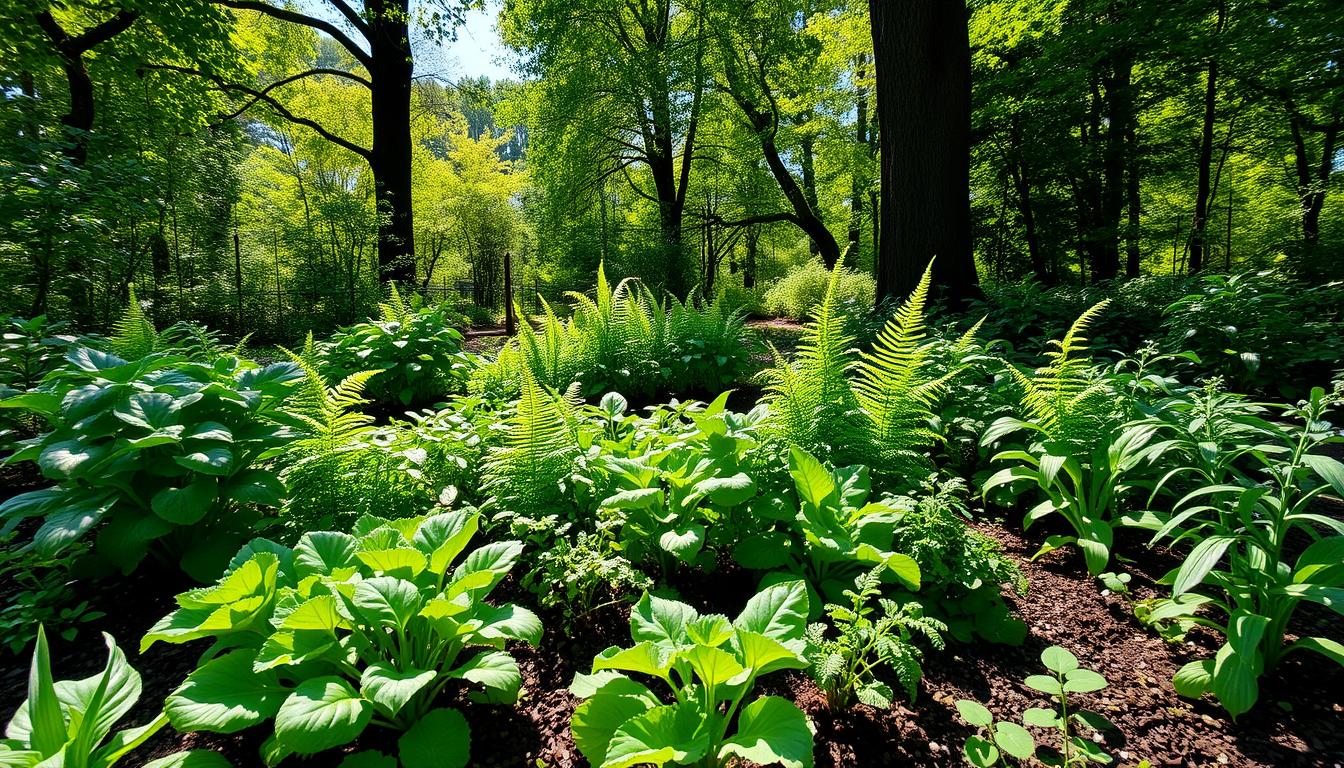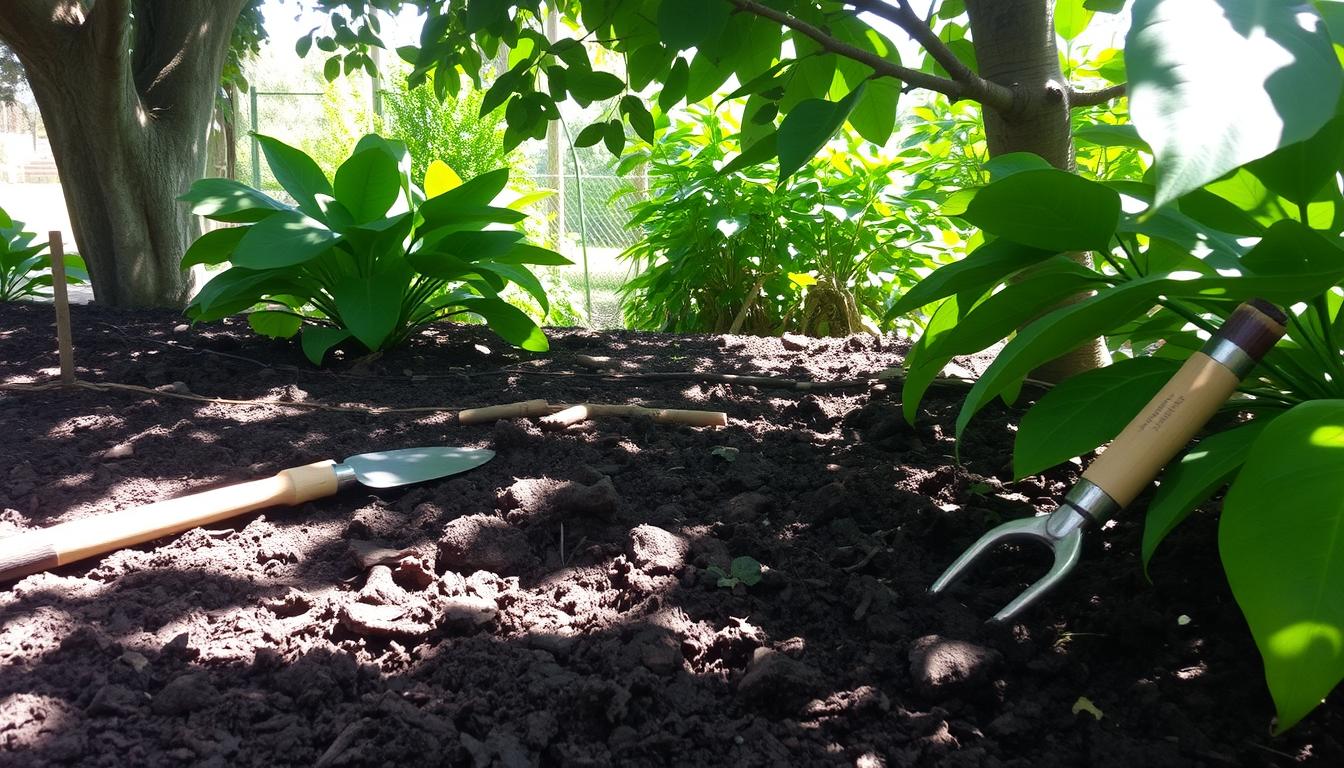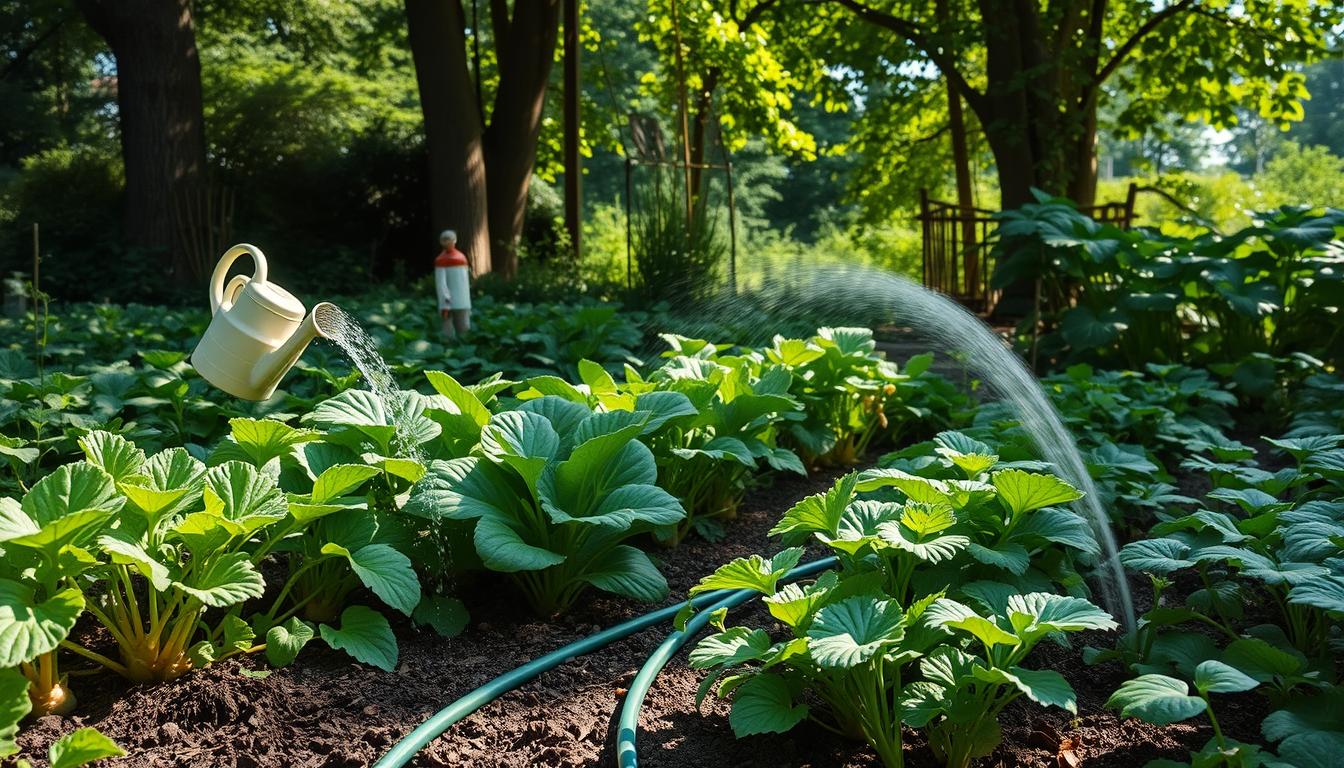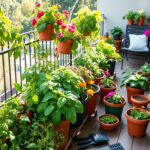Shady spots can grow delicious vegetables! Many edibles, such as spinach, kale, and lettuce, actually prefer partial shade, remaining tender and sweet with just 3-4 hours of sunlight.
Perfect vegetables for shade gardens include Swiss chard, bush beans, and carrots, which thrive in areas where other plants struggle. These clever growers transform unused corners into productive spaces.
Pro Tip: Morning sun with afternoon shade creates ideal conditions for shade-loving vegetables. Could you observe the light patterns in your garden to identify the best spots for these adaptable crops?
Understanding: Vegetables For Shade Gardens
Exploring shade gardening opens up new possibilities for gardeners with little sun. Not all veggies need full sun to grow well. Knowing about shade can greatly increase your gardening options.
For the best shade garden veggies, it’s key to know the different shades.
Gardens have various light levels that affect plant growth:
- Full Sun: 6-8 hours of direct sunlight daily.
- Partial Sun: 3-6 hours of direct sunlight.
- Partial Shade: About 3 hours of direct sunlight.
- Full Shade: Less than 3 hours of direct sunlight.
Light Conditions and Vegetable Growth
Different veggies need different amounts of light. Leafy greens do well with just 3-4 hours of sunlight daily. Root veggies can grow in 3-4 hours of direct sunlight.
Vegetable type, minimum sunlight required and performance chart:
| Vegetable Type | Minimum Sunlight Required | Performance |
| Salad Greens | 3-4 Hours | Excellent in partial shade. |
| Root Vegetables | 4-5 Hours | Good growth. |
| Herbs | 04 Hours | Varied growth rates. |
A gardener’s wisdom,
Shade doesn’t mean defeat in gardening—it means opportunity!
Knowing about light helps pick the right veggies for your garden. Shade gardening is about finding the right plants for your space, not being limited by it.
Benefits of Growing Vegetables in Shade
Gardening in shaded areas is not a limitation. It’s a chance to grow unique and tasty vegetables that do well in cooler spots. Some vegetables even grow better when they don’t get too much sun. This gives gardeners new ways to grow their plants.
Shade Tolerant Vegetable Garden
Learning about the perks of growing shade-tolerant vegetables can change how you garden. Let’s look at the surprising benefits that make shade gardening exciting for home gardeners.
Cooler Temperatures and Reduced Plant Stress
Vegetables in shaded spots get less heat stress. Cool-season crops can grow longer because they avoid the hottest sun. Shade helps plants grow well, keeping them from wilting and losing nutrients.
Protection from Sunburn and Scorching
Some vegetables can’t handle strong sunlight. Growing shade-tolerant vegetables keeps them from getting sunburned. Leafy greens like spinach and lettuce stay tender and don’t get bitter.
Extended Harvest Seasons
- Peas can grow longer than usual.
- Root vegetables become sweeter and tenderer.
- Cool-season crops keep producing longer in shade.
An expert says,
Shade gardening isn’t just about compromise—it’s about discovering new possibilities in vegetable cultivation.
By seeing shade as a help, gardeners can make diverse, productive gardens. It’s all about knowing which vegetables like lower light and giving them the right care.
Best Vegetables for Partially Shaded Areas
Growing vegetables in partially shaded areas is a great option for gardeners with limited sunny spots. Not all shade loving vegetables need full sun to grow well. Many can do great with just a few hours of direct sunlight.
Vegetables for shady areas can grow well with 4 to 6 hours of sunlight daily. This is good news for gardeners with less-than-ideal light.
Leafy Greens: Nature’s Shade Champions
Leafy greens are perfect for partial shade. Spinach and kale do well in cooler, shadier spots. They often grow longer than other vegetables. These greens can give you multiple harvests throughout the season. They’re great for shade gardens.
- Spinach matures in 28 to 55 days.
- Kale can be harvested from baby stage onwards.
- Lettuce reaches maturity around 50 days.
Root Vegetables: Surprises in the Shade
Root vegetables like beets and carrots can also grow well in partial shade. They can produce good yields with just 3-4 hours of direct sunlight.
Vegetable, Maturity time and planting depth chart:
| Vegetable | Maturity Time | Planting Depth |
| Beets | 7-9 Weeks | ½ Inch. |
| Radishes | 3-4 Weeks | ½ Inch. |
Pro Tip: While shade-loving vegetables can grow well, their yield might be slightly less than full-sun gardens.
Gardening wisdom,
Not all gardens are created equal, and not all vegetables need full sun to thrive!
Ideal Vegetables for Full Shade Conditions
Not all gardens get lots of sunlight, but you can grow tasty veggies in the shade. Some plants do great in little sunlight. I’ll show you some surprising veggies that can make dark spots in your garden useful.
Shade Vegetable Gardening
Mushroom Cultivation: A Shade Garden Delicacy
Mushrooms love the dark and damp. They grow best in full shade, where other veggies can’t survive. You can make a special area for mushrooms in your garden’s darkest spot.
- Oyster mushrooms grow exceptionally well in shade.
- Shiitake mushrooms thrive in woodland-like conditions.
- White button mushrooms enjoy consistent cool temperatures.
Herbs that Love the Shadows
Some herbs do well in the shade and can brighten up dark spots. Mint, known for spreading, is great in full shade. It can be planted directly in the ground without taking over your garden.
In the world of shade gardening, what seems like a limitation can become an opportunity for unique vegetable cultivation.
Shade-Tolerant Herb Selection
- Mint: Grows wonderfully in full shade.
- Chives: Thrives in partial to full shade conditions.
- Parsley: Adapts well to limited sunlight.
Knowing which veggies do well in the shade can turn useless spots into productive areas. Shade garden veggies offer many options for those with little sunlight.
Soil and Preparation for Shade Gardening
Starting a shade garden is all about understanding the unique challenges of growing vegetables in the shade. Shaded areas need special soil preparation to succeed.
Shade Garden Soil Preparation
Assessing Soil Quality in Shaded Spaces
Soil testing is key when planning a shade garden. You can get soil-testing kits at local stores or contact your County Cooperative Extension office for a detailed soil analysis. Most woodland plants prefer a pH between 6.0 and 6.5. Some plants, like azaleas, do well at slightly lower pH levels.
Improving Drainage and Nutrients
Shaded areas have unique soil needs.
Here are some ways to improve your soil:
- Add organic matter to improve soil structure.
- Use pale-colored mulches to reflect light and help plants grow.
- Include well-decomposed compost to increase nutrient levels.
Here are more tips for growing shade garden vegetables:
- Check soil pH regularly, even under evergreen trees.
- Manage fall leaves to avoid suffocating plants.
- Plant in spring or fall when the soil is best.
Pro Tip: Raised beds help control soil quality and improve growing conditions for shade-tolerant vegetables.
It’s critical to know the light conditions for choosing the right vegetables for your shade garden. Different plants tolerate shade differently. Matching your vegetables to the light will help you get a better harvest.
Watering Techniques for Shade Gardens
Growing veggies in shade needs a special way to water. Shade gardens hold water better than sunny spots. Knowing this helps keep your shade garden veggies healthy and well-watered.
Shade Garden Watering Techniques
Moisture Retention Fundamentals
Shade gardens keep water longer because they get less sun. Strategic watering is key for plant health. Most veggie roots go 6 to 12 inches deep, so watering must be precise.
- Water early morning for best absorption.
- Aim for consistent moisture levels.
- Avoid overwatering shade-loving vegetables.
Efficient Watering Techniques
Watering wisely is important in shade gardening. Drip irrigation can cut water use by up to 50%. Use drip lines with the right spacing for exact water delivery.
Pro Tip: Mulching can significantly improve moisture retention in shade gardens!
Watering Frequency Guidelines
Most veggies need 1 to 2 inches of water weekly. Container plants in shade might need more water because they have smaller roots. Look for signs of stress like yellow leaves or brown edges to check if you’re watering right.
Vegetable type, water needs and shade tolerance chart:
| Vegetable Type | Water Needs | Shade Tolerance |
| Leafy Greens | 1-1.5 Inches/Week | High. |
| Root Vegetables | 1-2 Inches/Week | Moderate. |
By using these watering tips, your shade garden veggies will stay healthy, hydrated, and productive all season.
Fertilization Tips for Shade-Grown Vegetables
Growing vegetables in the shade needs special care for their nutrition. Shade-tolerant veggies have different needs than those that love the sun. Knowing how to feed them can greatly improve your garden’s yield.
Choosing the right way to fertilize is key for shade veggies. Each type needs its own mix of nutrients for healthy growth and plenty of harvests.
Organic Fertilization Options
Here are some organic ways to feed your shade garden:
- Compost: It’s full of nutrients and makes the soil better.
- Aged Manure: It gives balanced food for plants.
- Organic Mulch: It keeps moisture in and slowly feeds the plants.
Fertilizer Application Strategies
Fertilizing right depends on the veggies you grow. Not all shade-grown plants need the same food.
Vegetable type and fertilization needs chart:
| Vegetable Type | Fertilization Needs |
| Heavy Feeders | Need more food often.. |
| Moderate Feeders | Do well with balanced, less frequent food. |
| Light Feeders | Don’t need much food. |
Remember: Over-fertilizing can be just as harmful as under-fertilizing!
Vegetables like leafy greens and root crops do well with steady, but not too much, food. Watch how your plants grow and adjust the food they get. This will help your shade garden do its best.
Companion Planting in Shade Gardens
Companion planting makes shade gardens lively and productive. It pairs shade-loving veggies to boost growth, taste, and fight pests.
Some veggies do great together in the shade. Planting them wisely can make your garden 25% more productive. It’s smart to pick plants that help each other grow well.
Optimal Plant Combinations for Shade
- Leafy greens with aromatic herbs.
- Root vegetables with tall companion plants.
- Nitrogen-fixing beans near shade-tolerant crops.
Enhancing Garden Ecosystem
Companion planting in shade gardens has many perks. Mixing crops can cut down pests naturally. For example, marigolds can lower pests by 40-60% if placed right.
Companion plants and benefits chart:
| Companion Plants | Benefits |
| Borage | Attracts 40% more pollinating bees. |
| Garlic | Reduces aphid populations by 80%. |
| Nasturtiums | Reduces fruit tree pest infestations by 50%. |
Top Tip: When designing your shade garden, think about plants that help each other grow and protect each other.
The secret to a thriving shade vegetable garden lies in understanding plant interactions and creating a balanced ecosystem.
Using these companion planting tips, you’ll turn your shade garden into a strong, fruitful space. It will make the most of the sunlight it gets.
Maintaining a Shade Vegetable Garden
Keeping a shade garden healthy needs attention and special care. I’ve found that plants that grow in the shade need extra help to do well. This ensures they give us a lot of food.
Pruning and Managing Growth
It’s important to manage how plants grow in the shade.
I suggest a few steps:
- Take out dead or yellow leaves to help air move better.
- Thin out plants to stop them from getting too crowded.
- Prune nearby trees to let more light in.
Using containers is a great way to grow shade-tolerant veggies. Even small containers, like 6 inches in diameter, can help move plants to better light spots.
Dealing with Pests in Shaded Areas
Shade gardens face special pest problems. Slugs and snails like these cool, wet spots.
Here are some ways to fight pests without chemicals:
- Use beer traps to catch slugs.
- Wait to put down mulch until it gets warmer.
- Check plants often for pest damage.
Gardening expert says,
Vigilance is key in maintaining a healthy shade vegetable garden.
Succession planting helps control pests and keeps veggies coming. Planting transplants with seeds keeps a steady flow of food all season.
Vegetables that grow in the shade need special care. Knowing your garden’s unique conditions helps make a shade garden that’s full of fresh, tasty food.
Tips for Successful Harvesting in Shade
Harvesting shade garden vegetables needs careful attention and special techniques. I’ve learned that timing is key when picking your crops. Shade-grown veggies mature differently than those in full sun, so knowing their harvest times is vital.
When growing shade garden veggies, check them more often. They take longer to grow, so you need to inspect them more frequently to avoid over-ripening. Leafy greens like spinach and kale get bitter fast if picked too late, so timing is everything.
Storing shade-grown produce is a bit different from sun-grown. I make sure to clean them well and refrigerate them quickly to keep them fresh. Root veggies like beets and carrots from shade gardens are delicate, so handle them gently. By mastering these harvesting tips, you can get the most out of your shade garden and enjoy a rich, tasty harvest.
Frequently Ask Questions (FAQ)
What types of vegetables grow best in shade?
Leafy greens like spinach, kale, and lettuce are great for shady spots. Root veggies such as beets, carrots, and radishes also do well in partial shade. Herbs like mint and chives are very shade-tolerant and can grow well in low light.
How many hours of sunlight do shade-tolerant vegetables need?
Most shade-tolerant veggies need 3-4 hours of direct sunlight or bright, filtered light. Leafy greens can handle 2-3 hours of direct sun. Root veggies need about 4-5 hours of sunlight for best growth.
Can I grow vegetables in full shade?
Yes, you can grow veggies in full shade. Mushrooms are a great choice for completely shaded areas. Some herbs like mint and chives can also grow in full shade, but they might grow slower.
How do I improve soil conditions in a shady garden?
To improve shady garden soil, add compost and aged manure. Use raised beds to help with drainage and prevent soil compaction. Getting a soil test can help address nutrient deficiencies in shaded areas.
What are the biggest challenges of growing vegetables in shade?
The main challenges include slower growth, reduced yield, and higher risk of fungal diseases. Shaded areas often have more moisture and less air circulation, leading to mold and mildew. Proper soil preparation and spacing can help overcome these issues.
How often should I water vegetables in a shade garden?
Shade gardens need less frequent watering because of lower evaporation. Monitor soil moisture closely. Use mulch to keep moisture in and consider a drip irrigation system for gentle watering. Check soil moisture every 2-3 days and water when the top inch feels dry.
Can I use companion planting in a shade garden?
Yes, you can! Companion planting is very useful in shade gardens. Pair shade-tolerant veggies with herbs that do well in similar conditions. Use taller plants to create microclimates and protect more sensitive veggies.
What fertilizers work best for shade-grown vegetables?
Organic, slow-release fertilizers are best for shade gardens. Use compost, worm castings, and balanced organic fertilizers for nutrients. Avoid high-nitrogen fertilizers that can make plants weak and leggy in low light.




















